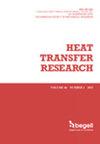Optimization of Micro Heat Sink with Repetitive pattern of Obstacles for Electronic Cooling Applications
IF 1.6
4区 工程技术
Q3 THERMODYNAMICS
引用次数: 0
Abstract
Micro Heat Sinks (MHS) are becoming integral part of microelectronics nowadays because of their ability to cool the tiny components which generate high heat flux. In this study, an electronic chip with a high heat flux of 100 W/cm² is cooled with the help of a MHS device which has repetitive patterns of obstacles of various shapes in the flow of cooling medium. Numerical modelling of all MHSs were performed using a Computational Fluid Dynamics (CFD) solver and the pattern, which gives better thermo-hydraulic performance, was selected for optimization. A parametric study was performed with various obstacle sizes, distance between obstacles and flow rate of cooling medium for maximum temperature of chip and pressure drop. Regression analysis was carried out with Response Surface Method (RSM) between these three design variables and two objective functions, viz. thermal resistance (Rth) and pumping power (Pp). A multi-objective optimization of the MHS was performed using genetic algorithm (GA) and pareto-optimal solutions were obtained. An optimal design was fabricated and the cooling experiment was carried out under optimal flow conditions. The repetitive pattern of obstacles increases the conjugate heat transfer area and helps in improving thermal performance.优化电子冷却应用中具有重复障碍物模式的微型散热器
微型散热器(MHS)能够冷却产生高热流量的微小元件,因此已成为当今微电子技术不可或缺的一部分。在这项研究中,一个热流量高达 100 W/cm² 的电子芯片借助 MHS 设备进行冷却。使用计算流体动力学(CFD)求解器对所有 MHS 进行了数值建模,并选择了热液压性能更好的模式进行优化。对各种障碍物的尺寸、障碍物之间的距离和冷却介质的流速进行了参数研究,以获得芯片的最高温度和压降。在这三个设计变量和两个目标函数(即热阻 (Rth) 和泵功率 (Pp))之间采用响应面法 (RSM) 进行了回归分析。利用遗传算法(GA)对 MHS 进行了多目标优化,并获得了帕累托最优解。制造出了最佳设计,并在最佳流动条件下进行了冷却实验。障碍物的重复模式增加了共轭传热面积,有助于提高热性能。
本文章由计算机程序翻译,如有差异,请以英文原文为准。
求助全文
约1分钟内获得全文
求助全文
来源期刊

Heat Transfer Research
工程技术-热力学
CiteScore
3.10
自引率
23.50%
发文量
102
审稿时长
13.2 months
期刊介绍:
Heat Transfer Research (ISSN1064-2285) presents archived theoretical, applied, and experimental papers selected globally. Selected papers from technical conference proceedings and academic laboratory reports are also published. Papers are selected and reviewed by a group of expert associate editors, guided by a distinguished advisory board, and represent the best of current work in the field. Heat Transfer Research is published under an exclusive license to Begell House, Inc., in full compliance with the International Copyright Convention. Subjects covered in Heat Transfer Research encompass the entire field of heat transfer and relevant areas of fluid dynamics, including conduction, convection and radiation, phase change phenomena including boiling and solidification, heat exchanger design and testing, heat transfer in nuclear reactors, mass transfer, geothermal heat recovery, multi-scale heat transfer, heat and mass transfer in alternative energy systems, and thermophysical properties of materials.
 求助内容:
求助内容: 应助结果提醒方式:
应助结果提醒方式:


